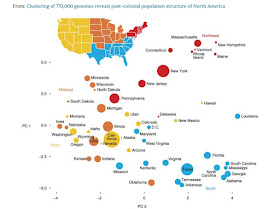 |
| https://www.nature.com/articles/ncomms14238 |
How do you identify your ancestors' clusters?
Genealogical clusters can be identified and used to expand your research by considering all of the possible relationships that your ancestors may have had with those who lived around them or with whom they associated. Clusters can be geographically determined or based on cultural, occupational, religious, social, or any other type of association. The illustration above refers to a study identifying genetic clusters. See "Clustering of 770,000 genomes reveals post-colonial population structure of North America."
Here is a rather simple illustration of how clusters can be identified from a U.S. Federal Census schedule. If I look at the Census for 1900 in a small community in Arizona where some of my relatives and ancestors lived, I find that my Great-grandfather appears on the following schedule:
 |
| https://www.familysearch.org/ark:/61903/3:1:S3HY-DCFQ-NFB?i=37&cc=1325221 |
This page of the 1900 Census record lists the "State" as "Arizona." Hmm. Arizona did not become a state until 1912 so we are dealing with a standard form that may mislead someone who is not aware of the background history. This is one of the fundamental issues with beginning jurisdictional analysis. What Arizona Territorial records would have been kept in 1900 and where would those records have been kept?
What else do we see on this record? Here are some of the things this record tells us:
- The record is from the St. Joseph Precinct in Navajo County. That suggests some places (jurisdictions) where the records may have been kept.
- The record was dated 30 June 1900. This may or may not be the date when the information was obtained since that is likely the "official" census date.
- The surnames of the families listed on this page include McLaws, Hansen, Tanner, Richards, Tanner, and Tanner. How are these people related, if they are?
- Looking at the birthplaces listed, we see the following countries or states Arizona, Utah, England, Denmark, Scotland, Canada, Kentucky, California,
We could go on. One of the people listed is a Naturalized Citizen. Many of the children are in school. Most of the men are listed as farmers. But what is not so obvious is that they are all neighbors. These people all knew each other.
How were the three Tanner families related? This brings up a basic issue of cluster research. We have three Tanner families. The heads of the households are:
- Martin Tanner Jr. age 22
- Henry M. Tanner age 47
- Emma E. Tanner age 37
Almost all of the families listed have recent immigrant ancestors, i.e. parents who were born outside of the United States. Here is where we have to go beyond the record and beyond the jurisdictional analysis. Further research shows that the head of household named "Martin Tanner Jr." is Martin Ray Tanner, the first son of Henry Martin Tanner and his wife Eliza Ellen Parkinson. The head of household named, Emma E. Tanner is Emma Ellen Stapely Tanner, the second plural wife of Henry Martin Tanner. So, rather than two families of Tanners, all three of those named are actually part of the same family. How many of the other families in the St. Joseph Precint were involved in plural marriages? How did all these families relate to one another? Can we use that relationship to find out more information about the families? These are some of the questions that we can begin asking.
We now have the beginnings of a basis for investigating the "cluster" of all of the families that share a common condition. Not to keep anyone in suspense, they are all members of The Church of Jesus Christ of Latter-day Saints and even though the practice of polygamy had been discontinued before 1900, there were still families that were part of the recently terminated practice. This subject opens up a huge opportunity for understanding these family organizations and further suggests a huge number of possible records that exist that might be overlooked without identifying a common practice, a common religion, and a common situation in a small town in Arizona Territory.
The practice of polygamy or plural marriage was discontinued by The Church of Jesus Christ of Latter-day Saints beginning in 1889. See the following for further information.
- Plural Marriage in The Church of Jesus Christ of Latter-day Saints
- The Manifesto and the End of Plural Marriage
There is still a lot more to say about cluster research. Stay tuned.
Remember: There is no Step Two in this series. Here are the previous posts.
Step One: https://genealogysstar.blogspot.com/2019/03/a-step-by-step-approach-to-using.html
Step Two: missing but shows up as Step One
Step Three: https://genealogysstar.blogspot.com/2019/03/a-step-by-step-approach-to-using_19.html
Step Four: https://genealogysstar.blogspot.com/2019/03/a-step-by-step-approach-to-using_31.html

No comments:
Post a Comment